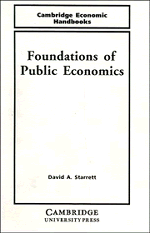Book contents
- Frontmatter
- Contents
- Preface and acknowledgments
- Notation
- PART I Scope and limitations
- PART II Decision making in a mixed economy
- PART III First-order project analysis
- PART IV Evaluating large projects
- 14 Search for exact measures
- 15 Surplus approximations
- 16 Practical methods for large-project evaluation
- 17 Peak-load problem
- Epilog
- References
- Author index
- Subject index
15 - Surplus approximations
Published online by Cambridge University Press: 04 April 2011
- Frontmatter
- Contents
- Preface and acknowledgments
- Notation
- PART I Scope and limitations
- PART II Decision making in a mixed economy
- PART III First-order project analysis
- PART IV Evaluating large projects
- 14 Search for exact measures
- 15 Surplus approximations
- 16 Practical methods for large-project evaluation
- 17 Peak-load problem
- Epilog
- References
- Author index
- Subject index
Summary
We explored methods of measuring welfare change for large projects in the preceding chapter. Although we found it possible in principle to recover the necessary measures from sufficiently rich demand information, we were forced to conclude that the required information would almost never be available in practice. Indeed, most benefit–cost studies either restrict themselves to first-order analysis or use “naive” measures of “surplus” based on parametric estimates of aggregate demand functions.
Here, we investigate ways in which the state of the art might be improved somewhat. We search for measures that are closer to exact than those just mentioned yet are still accessible from data we might reasonably be able to collect. The first method examined will be “second-order approximations,” the natural generalization of first-order analysis to include one more term in the Taylor expansion. Measures based on second order or any order for that matter) have the advantage that they require only local information for implementation. Essentially, the method gives up on collecting hypothetical information concerning demand conditions in unobserved parts of the economic environment and instead extrapolates to those areas using curvatures at the status quo. Naturally, the method will be good only to the extent that there is some stability to the curvatures.
Quite apart from pragmatic issues, second-order approximation allows us to study the properties of second best when the status quo happens to be first best (first-order analysis simply generates first-best measures in this case). In particular, we will be able to quantify the concept of deadweight loss.
- Type
- Chapter
- Information
- Foundations in Public Economics , pp. 246 - 259Publisher: Cambridge University PressPrint publication year: 1988



